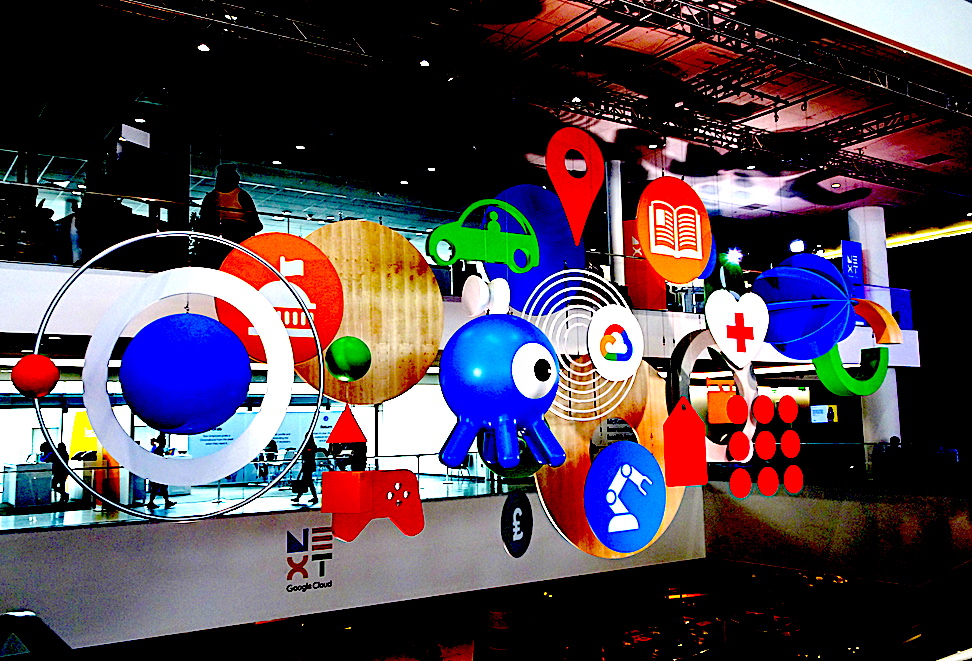 CLOUD
CLOUD
 CLOUD
CLOUD
 CLOUD
CLOUD
Hoping to steal a march on its bigger cloud computing rivals, Google LLC is shaking up its stack of serverless software that enables developers to building applications in a more automated way.
It’s doing so with a new offering called Cloud Run for developers announced today at its Cloud Next conference (pictured) in San Francisco. It enables them to build container-based applications without worrying about the underlying infrastructure.
Serverless computing refers to a model in which the compute and storage infrastructure that applications are built on is run in the background, so developers don’t need to managing it all. Software containers, in turn, are a popular development environment that enables apps to be built once and run on any computing platform.
Eyal Manor, Google’s vice president of engineering, and product management director Oren Teich explained in a blog post today that developers face a significant challenge in getting these two technologies to work in tandem. Because of limited runtime support, developers are often forced to choose between the ease of use that serverless infrastructure offers or the flexibility and portability benefits provided by containers.
Google said that simply isn’t good enough, so its new offering provides the best of both worlds by allowing developers to run stateless HTTP-driven containers on serverless infrastructure for the first time. In short, Teich said in a press briefing, this takes a container and provides and easily accessible URL or web address for it.
“You just give us the container and we take care of everything else,” such as routing and scaling up and down, Teich said. “Everything is handled for you automatically.”
Cloud Run is being offered in beta as both a standalone service and integrated with Google Kubernetes Engine, which is a managed environment for deploying, managing and scaling container apps on Google infrastructure.
There are some significant benefits to running Cloud Run on GKE, the main one being the ability to run serverless workloads on existing Kubernetes clusters without needing to manage either of them.
“Google’s latest announcement places serverless at the forefront of open programming frameworks for cloud-native applications,” said James Kobielus, an analyst with SiliconANGLE sister analyst firm Wikibon.
In particular, it brings several advantages, Kobielus said. For one, Google’s support for Knative enables serverless functions to be easily ported to any Kubernetes cluster, greatly expanding the runtime reach for this new generation of event-driven, stateless and containerized microservices.
Moreover, he said, the new language runtimes will make it easier to develop more powerful serverless applications and, with Cloud Run, run those apps more efficiently in the cloud. And lastly, there’s expanded support for secure serverless applications in the hybrid cloud, thanks to the beta of a new connector that lets developers pull data securely from existing virtual private clouds into serverless apps in Google Cloud Platform.
“Executives will welcome the chance for their next-generation applications to leverage existing GKE clusters, helping with utilization and even more importantly co-existence between containers and serverless application loads,” said Holger Mueller, principal analyst and vice president of Constellation Research Inc.
Google especially talked up the benefit of developers not being restricted to running serverless workloads on Google’s cloud alone. Because Cloud Run is based on the Knative application programming interface and runtime environment, workloads can be migrated to other infrastructures, including on-premises environments and other public and private clouds.
“Thanks to Knative, it’s easy to start with Cloud Run and move to Cloud Run on GKE later on,” Manor and Teich wrote. “Or you can use Knative in your own Kubernetes cluster and migrate to Cloud Run in the future.”
Of course, serverless applications aren’t very useful if they can’t connect to other cloud services. That’s the purpose of Google’s Cloud Functions serverless platform, which is used to write code that responds to events, enabling developers to connect their apps to services such as Google BigQuery, PubSub and Firebase.
Cloud Functions is gaining enhanced functionality including support for new language runtimes such as Node.js 8, Python 3.7, Go 1.11, Node.js 10, Java 8 and Go 1.12. There’s also a new Functions Framework for Node.js 10 that enables developers to “write a function, run it locally and build a container image to run it in any container-based environment,” Manor and Teich said.
Other new updates include Serverless VPC access, which enables functions to communicate with resources protected by network boundaries, and scaling controls that are designed to prevent auto-scaling functions from overwhelming backend servers.
By combining Cloud Functions with Cloud Run, it’s now possible to create apps that leverage services such as databases, storage, messaging, data analytics, machine learning and smart assistants, Google said.
Finally, Google is adding new runtimes to its App Engine service, which is its original serverless application development platform.
App Engine now supports new runtimes including Node.js 10, Go 1.11, PHP 7.2, Ruby 2.5 and Java 11. The first three are generally available now, the last two offered in beta.
“These runtimes provide an idiomatic developer experience, faster deployments, remove previous API restrictions and come with support for native modules,” Google said.
Pali Bhat, Google Cloud’s vice president of product and design, spoke to theCUBE, SiliconANGLE’s livestreaming studio covering Cloud Next this week, about how Google is looking at serverless computing:
With reporting by Robert Hof
Support our mission to keep content open and free by engaging with theCUBE community. Join theCUBE’s Alumni Trust Network, where technology leaders connect, share intelligence and create opportunities.
Founded by tech visionaries John Furrier and Dave Vellante, SiliconANGLE Media has built a dynamic ecosystem of industry-leading digital media brands that reach 15+ million elite tech professionals. Our new proprietary theCUBE AI Video Cloud is breaking ground in audience interaction, leveraging theCUBEai.com neural network to help technology companies make data-driven decisions and stay at the forefront of industry conversations.